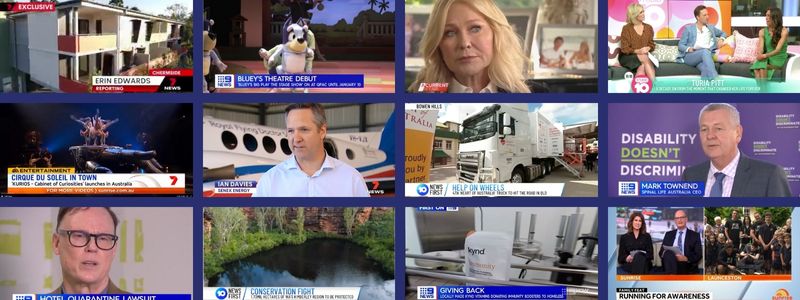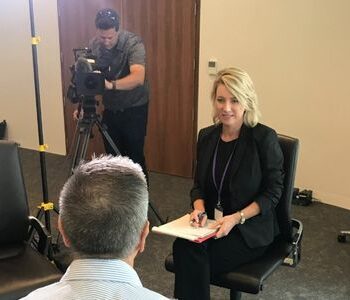How to get your story in the news
Have a great story to tell? Or maybe there’s a major event that you want to publicise? Getting your story in the news is a great way to get your business noticed.
Dealing with the media can seem daunting but it’s highly valuable so it’s important to know how to get your story in the news.
In this blog, we unpack our 3-step process to getting your business noticed and in the news.

We will cover:
- How to write a newsworthy media release
- How to build a media list that works
- How to successfully pitch your story to the media.
How to write a powerful media release
The easiest and most common way to get in touch with the media is through a media release.
A media release needs to well-written, informative, and enticing. It’s why many businesses rely on PR agencies and their teams of expert communicators to use their skills, and knowledge of how the media works, to craft media releases and pitch your story to journalists.
Why use a media release?
Media (or press) releases are used to obtain free publicity. It’s free in that you don’t pay the media network to run the story (that’s advertising). One benefit of public relations vs advertising or marketing is that audiences attach greater credibility to something they see in the media as opposed to a paid ad. When journalists tell your story, it adds third-party credibility, which some sources say has up to 10 times the impact of traditional paid advertising.
Here is our checklist for creating a powerful media release:
A newsworthy angle and point of difference
To be successful, your media release MUST be newsworthy. It must have an angle that makes it relevant and worthy to be covered to the journalist and their audience.
Every business has stories, expertise, or advice to share. The key is being able to attach a relevant and compelling news angle to your story. This angle is what makes your story interesting to media outlets.
Attaching a strong news angle to your story is what is going to grab a journalist’s attention and make them run your story.
Types of news angles include:
- Conflict – the media loves a fight or scandal where people or organisations are pitted against each other (although this can backfire and get messy so proceed with caution)
- Timeliness – new acquisitions, a new service, new statistics, new technology – anything new or breaking is instant news. Likewise aligning your media release to current events or topical dates (for example, World Water Day) can help make your story become more newsworthy
- Prominence – the larger your or your business’s profile, the more “newsworthy” you become. If you are prominent, even small events can seem significant
- Proximity – news editors are very parochial so the story must be locally relevant.
- Human Interest – a story with a human element that evokes emotion.
Struggling to decide if your story is newsworthy? Adoni Media Managing Director, Leisa Goddard recommends the water cooler test.
“You should ask yourself, is it a story that would have you and your colleagues talking around the water cooler? If yes, then chances are you have a newsworthy story,” she said.
Hook them in with your headline
When a journalist reads your media release, the very first thing they will look at is your headline. Your headline must pique the journalist’s interest right away so they are inclined to read more.
Your headline should be short and written in an active voice. It’s important to make your headline as compelling and attractive to the media as much as possible. This is why you need to include a strong hook that makes your story topical.
The importance of the lead paragraph
The lead paragraph must provide the journalist with an understanding of what your media release is about. If you bury this information lower down, the story will become unclear, and the media is unlikely to run your story.
When writing your media release, it is important to use the Inverted Pyramid Structure. This means you should write your key points in descending order, from most important to least important. Use your first few sentences to explain the who, what, when, where, why, and how of your story.
By including the important information at the top, it makes your story clear to the journalist and means if your media release gets shortened in the journalist’s story, the most important information survives.
Use clear, simple language
Avoid complex jargon or phrases. The language used in the boardroom is very different to what is required in a media release. A media release needs to be easily understood by a wide audience – this means keeping your language simple and direct.
Use quotes to substantiate claims
Within the body of your media release, include 1-2 quotes from a company spokesperson. This will add substance to your media release and put a face to your company. It’s also important for this spokesperson to be available for interviews on the same day you send out your media release should a journalist call.
Keep it factual, relevant, and concise
Everything you write in your media release must be factual. Don’t make outlandish claims and ensure you can back up anything you say.
Ideally, a media release should fit on one page. It’s also important to only include relevant details as this will help keep your media release concise. If a journalist needs more information, they will contact you. Any additional information can be included in a Fact Sheet within your Media Kit.
Add contact details
Include your name, number, and email at the bottom of the media release. Journalists need this information to ask follow-up questions and arrange interviews.
Check and re-check
Proofread your media release, read it aloud, and have a colleague do the same. You want to make sure all information is accurate and spelt correctly – check the spellings of names, locations, dates and any other details in the release.
What is a media kit?
In addition to your media release, every business should have a Media Kit. A Media Kit is simple to put together and can improve the chances of a journalist telling your story.
The goal of your Media Kit is to provide journalists with the resources needed to share your story accurately and professionally. It gives them further details about you and your company which provide additional background and supplement a media release.
What goes in a Media Kit?
- A fact sheet including key information about your business (often including your mission statement)
- Bios for the leading members of your team/company spokespeople
- Your company logo
- High-quality images (for example, headshots of your leadership team, product photos, and pictures of your team working).
How to build a media list
Once you have a newsworthy media release, it’s time to start pitching. Pitching is where you contact specific journalists and media outlets to tell them your story and encourage them to run it. You can pitch via email or phone (ideally both), but before you start, you must first decide who to pitch to.
While getting in touch with the media and pitching your story can be done quickly, building strong relationships with media outlets and journalists takes time. This is why many companies seek out the help of Public Relations agencies whose staff already have lengthy relationships with people working in the media, and strong media relations skills.
Building a network of media contacts
Putting together a media contact list is something that is done over time and is added to and updated often.
When creating your media lists, you need to consider the following types of media coverage:
- Where – local, state, or national?
- Who – TV, radio, online, magazines, or print?
- What – mainstream media, niche, or industry publications?
The answers to these questions should be guided by your target audience – that is, who you want to hear your news. Investigate the types of media your audience consumes so you can best reach them. Create a list of media outlets you want to share your story with.
Once you know the outlets you wish to target, it’s time to start finding contacts to add to your media list.
How to find media contacts
One of the most valuable media contacts you can have on your media list is the Chief of Staff (also known as the COS). The Chief of Staff is the gatekeeper of any newsroom – they decide what stories are covered and assign the journalists to cover each story.
The other entry point is to send a media release directly to a journalist who has an interest in your area of expertise or who you have a relationship with.
The next challenge is finding contact details. In some cases, you will be able to find this on the outlet’s website – if that doesn’t work, try LinkedIn or Twitter. If you are unable to find any contact details, you may want to consider using a media database or again enlisting the services of a PR agency whose team has extensive personal contacts, as well as access to databases.
Create your media list and include details such as outlet, full name, email, phone number, job title, and location. Other details you may wish to include are Twitter usernames, previous articles they have written, and deadlines. It’s typically easiest to record these details in a table or excel spreadsheet.
How to pitch to the media
You’ve done the bulk of the work, now it’s time to hit send. Chiefs of Staff and journalists receive hundreds, if not thousands, of emails a day. Therefore, it is critical to have a subject line that catches their attention. It must be interesting enough for them to open your email to read more.
Each pitch should be personalised for the recipient. Acknowledge them by name and, if relevant, mention recent stories they’ve published. Your pitch also needs to be compelling and concise, explaining why they should be interested in your story. It should also contain key details as well as a link to your Media Kit so that, if they choose to run your story, they can get more information.
Your pitch needs to include your media release, so ensure it’s attached. And lastly, leave your name, number, and email so the journalists can get in touch. They’ll need a way to reach you if they need any extra information or want to do an interview.
How to pitch your story to different media
How to pitch to TV stations
TV stations rely on pictures to tell a story. This means there is no point pitching your story to TV outlets if there is nothing interesting for them to film. You can make your pitch more attractive to TV journalists by offering up opportunities for them to film something compelling, or putting talent forward for a media interview. Stations will also sometimes run footage supplied by a company if it’s shot the right way.
A TV interview can be great exposure for your brand because it helps to put a human face to your business. When your audience can see you, they are better positioned to connect and build trust with your brand.
Another strategy to consider is including a Video News Release (VNR). A VNR provides TV newsrooms with vision of your story as well as interview grabs. TV newsrooms are notoriously busy, so a VNR means crews don’t necessarily need to attend a media event which may increase the chance that your story will get picked up. You can learn more about how to get your story on TV using a Video News Release here.
When it comes to pitching to TV stations, timing is critical. It’s best to send your media release (or VNR) early in the morning. This gives the journalists time to arrange and film an interview, attend your event (if you are having one), and edit your story.
After hitting send, it’s best to call the newsrooms to let them know you’ve sent the media release, pitch your story, and ask if they need anything else to run the story. This can help prevent your story from getting lost in an overflowing email inbox.
How to pitch to radio stations
Radio journalists work at an extremely fast pace which is why a phone call is essential. An email on its own is likely to become lost.
When pitching to radio, you need to provide a spokesperson they can interview. In your pitch, you need to explain why your spokesperson would be a great person to interview and how your story is newsworthy.
Before you call, make sure to write down what you are going to say and practise. Chances are you’ll appear more confident, and knowledgeable, and you will be able to get your point across more quickly.
Do not call a radio journalist or producer while they are on air – they are too busy at this time. Take the time to research what time the radio program airs and make your call shortly before or after the broadcast.
If you’re seeking coverage in a radio news bulletin rather than a program, a good rule of thumb is to not call on the hour or the half-hour but around quarter past or quarter to the hour when journalists are not in the booth reading the news and have time to listen to your pitch and conduct an interview.
How to pitch to print/online
When pitching to print/online, is it so important to send your story to the right person. Newspapers have various sections, each with a different editor in charge. Make sure your pitch is relevant to the editor/journalist who receives it – if not, it will end up in the bin.
Most journalists and editors are working to deadlines every day, sometimes multiple times a day. Be sure to find out their deadline and time your pitch accordingly. Consider when the newspaper is printed and circulated to make sure you pitch your story before it’s too late.
In PR, there is no such thing as guaranteed media coverage, but following the steps outlined in this blog, is sure to put your business on track to get noticed.
Learning how to get a story in the news is a worthwhile investment for your business. By earning media coverage, your business will increase its exposure, which in turn boosts brand awareness and ultimately sales.
To supercharge your exposure and develop a winning PR strategy, consider using a PR agency such as Adoni Media.


